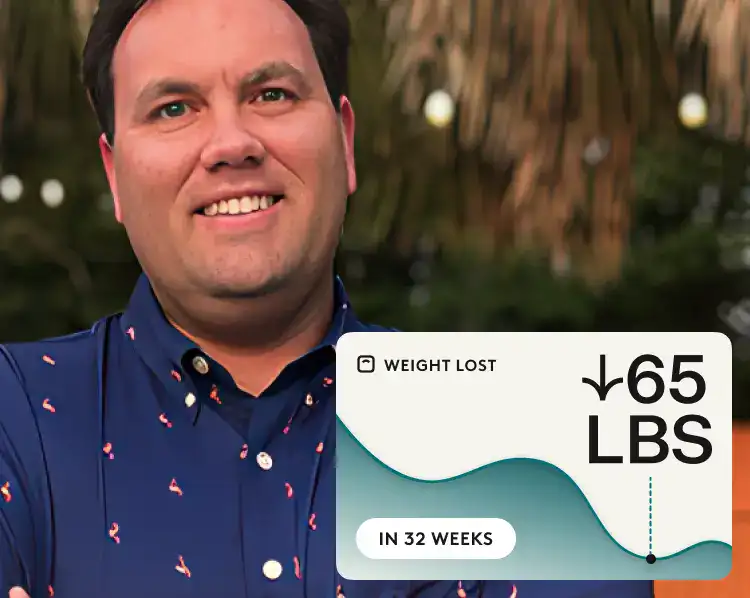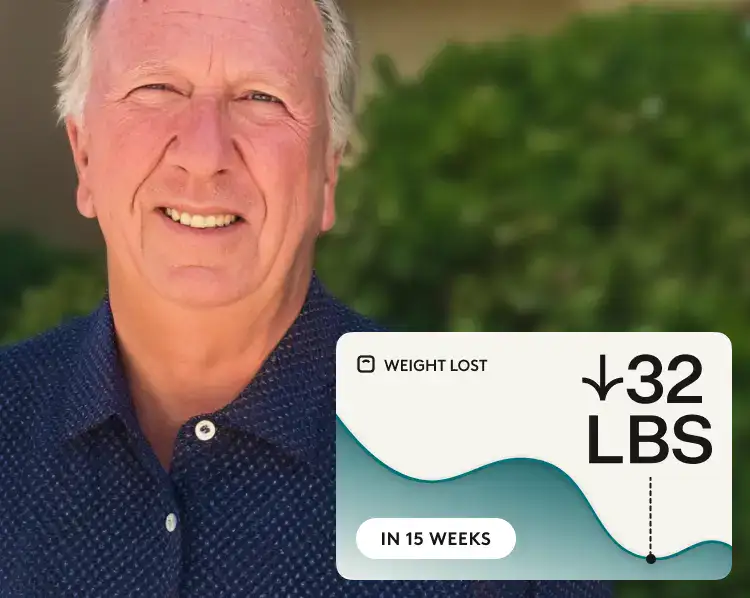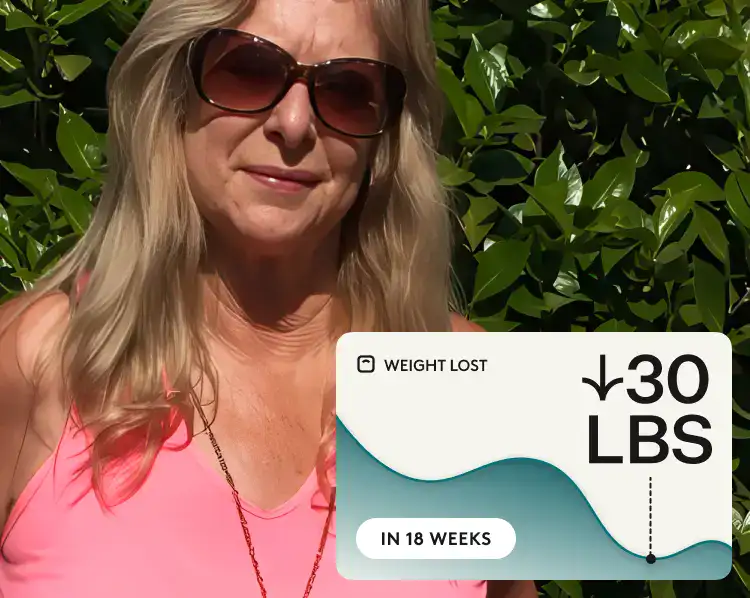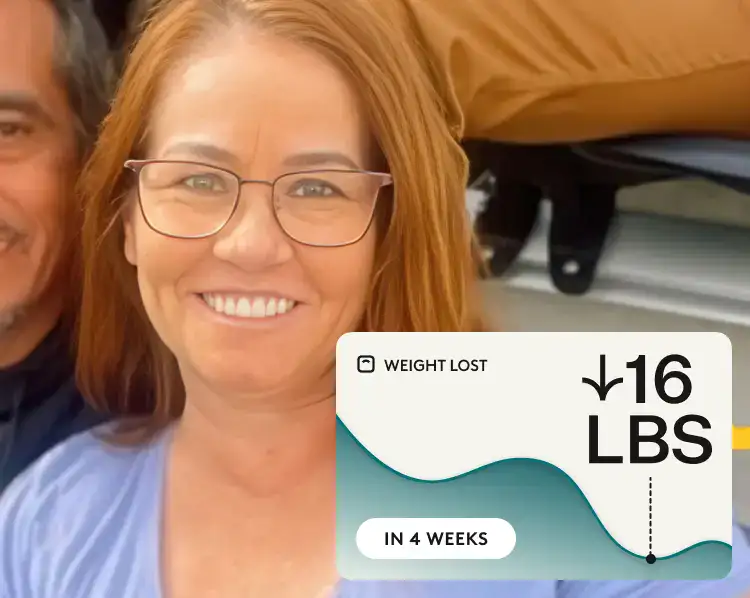- A calorie deficit is when a person burns more calories than they consume.
- To lose weight, a person must be in a calorie deficit.
- It’s important that the calorie deficit you are in is safe, healthy, and sustainable.
If you’ve ever tried to lose weight, you’ve probably heard of the term calorie deficit (also called “caloric deficit”).
You might already know that a calorie deficit is when you burn more calories than you take in. And you might also know that a calorie deficit is necessary for weight loss.
However, did you know that for many people a calorie deficit isn’t as simple as just eating less? Your calorie deficit must be sustainable—anything too restrictive may burn you out and lead to health problems.
To learn more about this topic, we talked to Noom coach and registered dietitian Kendra Gustschow, RDN, LD. She shared her expert advice on how to lose weight with a sustainable and safe calorie deficit.
Note: Consult with your medical provider before making dietary changes.
What is a calorie deficit?
Stated simply, a calorie deficit is when you burn more calories than you consume.
We get energy from the food we eat, and calories are a measure of that energy.
You burn calories with physical activity, but your body is also constantly using energy (calories) to function. Things like breathing, your heart pumping blood, and your brain at work all require energy.
Here’s a basic example of a calorie deficit:
Let’s say your body burns 2,000 calories in a day, and the total number of calories you take in is 1,500 a day. That’s a deficit of 500 calories in one day. (Keep in mind everyone is different and burns calories at different rates.)
A National Institute of Health study suggests that consistently burning more calories than you eat can lead to weight loss—and when this is done sustainably, it can lead to lasting results.
How does a calorie deficit cause weight loss?
As you’ve learned, our bodies need energy for all the activities we do each day, like moving, breathing, thinking, digestion, and more.
So when you are in a calorie deficit, your body is actually taking in less energy than you’re using.
Since we can’t violate the laws of physics, our bodies have to get that energy from somewhere. But where does it come from?
When you’re in a calorie deficit for enough time, your body taps into stored energy in your body (most often fat). This is what leads to weight loss.
Rx weight loss, the right way, with Noom
Get access to prescription weight loss medication with Noom.How to eat in a calorie deficit
Now that you know how a calorie deficit causes weight loss, you might wonder how to create that deficit for yourself.
Some say it’s simple: Just eat less and exercise more. However, that’s not the whole story.
You have to be in a calorie deficit for long enough to lose weight, while still making sure you’re eating enough calories (in other words, energy) for your body to function well.
Cutting your calories too low can cause health issues, like headaches, fatigue, and a weakened immune system.
Staying in a healthy calorie deficit starts with adopting sustainable eating habits.
When we think about changing our eating habits, we often imagine we’ll have to cut out entire food groups or be overly restrictive. But the truth is, drastic changes to eating habits are tough to maintain.
An overly restrictive diet can also make you feel tired and hungry.
If you cut out your favorite foods entirely, you may burn out and give up on trying to achieve a calorie deficit. Not ever eating your favorite foods again is not enjoyable, nor is it sustainable.
“In a lot of people’s minds, a diet is something you start and stop,” Coach Kendra says. “And that’s where the disconnect tends to be.”
Coach Kendra says you can lose weight without avoiding your favorite foods or dropping too many calories too quickly. The key is adjusting your eating habits gradually and sustainably.
Many people find that it’s easier to build sustainable eating habits with Noom Weight.
How much of a calorie deficit do you need to lose weight?
Because our bodies and lives are different, we all have unique calorie ranges for maintaining our current weight. It depends on many factors like height, age, weight, metabolism, physical activity, and more.
You’re within your maintenance calorie range when you burn and consume roughly the same amount of calories.
According to Coach Kendra, the average calorie deficit for weight loss is about 500 calories lower than your maintenance calorie budget. (That’s 500 fewer calories than your body burns.)
With a sustainable 500-calorie deficit, the average person can expect to lose roughly one pound per week.
However, keep in mind that everyone is different. For example, people at higher weights tend to lose pounds faster at first. When you increase your physical activity, your calorie deficit may also change.
How much of a calorie deficit is too much?
While you do need to eat in a calorie deficit to lose weight, you should never dip below the number of calories your body needs to function each day.
According to the U.S. Government dietary guidelines, depending on age and activity, a woman needs between 1,600 to 2,400 calories a day to maintain weight. A man needs 2,000 to 3,200 calories per day to maintain weight.
Going more than 500 calories below these amounts is generally too much. (Noom won’t let females adjust their calories below 1,200 to 1,320 calories per day or males below 1,400 to 1,540 calories per day.)
It’s also important to remember that your exact calorie range depends on a variety of things, including age, sex, height, and weight.
Other lifestyle and physical factors, like whether you’re lactating or how active you are, can also impact how many calories you need.
It’s important to listen to your body for signs that you are cutting too many calories, like feeling drained or fatigued, unable to concentrate, or irritable.
How to calculate a calorie deficit
If you’re wondering how to calculate a calorie deficit, there isn’t one way that works perfectly for everyone.
Why? Ideal calorie ranges vary based on physiological factors like age and sex.
Your calorie needs also change based on your physical activity level. You need more energy throughout the day when you consistently increase your daily activity (say, with weightlifting classes or a daily walk).
That also means you’ll need fewer calories if you take a long-term break from exercise.
A healthy eating program like Noom considers these factors to find a healthy, sustainable calorie deficit for you. Visit our calorie deficit calculator to get a close estimate (and learn how it’s calculated).
What if I’m not losing weight in a calorie deficit?
Sometimes the scale won’t budge, even when you’re in a calorie deficit.
It’s common to hit a plateau in your weight loss journey. Most people who stick with a new eating plan experience a plateau around the six-month mark.
However, many also find that if they stick with a calorie deficit, they keep moving in the right direction.
It’s normal to feel frustrated when you aren’t losing weight, especially if you saw fast results early on.
Still, plateaus are a great chance to try something new, like experimenting with different recipes or adding joyful movement to your day with a walk or yoga class.
Be patient with yourself and have a support system in place to help you. To learn more about what to do if you hit a plateau, check out our full article on what to do if you’re not losing weight on a calorie deficit.
How to lose weight with a calorie deficit
There are many different methods for losing weight with a calorie deficit.
At Noom, we believe that building sustainable food habits is a major factor in any healthy weight loss program.
Constantly worrying about what you can’t eat is exhausting—it can leave you feeling hungry, tired, and unmotivated. Making changes you can stick with is key to lasting weight loss.
Here are tips for losing weight with a calorie deficit, drawn from Noom Weight.
1. Address the emotional side of weight loss
If you notice yourself making the same choices day in and day out (like stress-eating after a busy afternoon at work), there’s probably an emotional trigger behind your habit.
It can be tough to make lasting changes without understanding the habits that hold you back. Try to uncover the reasons behind why you eat so you can make positive changes.
2. Choose foods that help you feel full on fewer calories
Not sure what to eat in a calorie deficit?
The simplest solution for healthy eating is to aim for foods with low caloric density, which help you feel satisfied while eating fewer calories.
Caloric density is the calories per serving of a food divided by the weight of the food (typically in grams). Water is key to caloric density—the more water a food contains, the lower its caloric density, so you can eat more and stay full on fewer calories.
Low-calorie-density foods also tend to provide more fiber and nutrients, which help you feel satiated.
Noom Weight simplifies caloric density by breaking food down into categories with a color system, where green represents low caloric density food.
3. Log what you eat
It’s easy to underestimate the caloric density of high-calorie foods when you‘re not logging what you’re eating.
When you track your food, you have a built-in daily accountability system that helps you spot these patterns and build awareness around your habits.
Research suggests keeping track of the food you eat is significantly associated with weight loss.
When you log your meals with an app like Noom Weight, you can be more conscious of your food intake.
4. Get support on your weight loss journey
It’s important to have support for the ups and downs of losing weight with a calorie deficit.
Friends, family, and your community may be able to help you.
However, many people find that a program like Noom Weight provides the support they need. Noom Weight offers coaching, guides, and a community to learn and celebrate wins with.
Ready to take the next steps? Noom is here to help
When you’re ready to start your weight loss journey, we’ve got your back.
Noom Weight will automatically calculate your calorie deficit, then teach you how to make choices that achieve sustainable, long-term weight loss.
Use Noom Weight’s free trial to get started today!
Why you can trust us
At Noom, we’re committed to providing health information that’s grounded in reliable science and expert review. Our content is created with the support of qualified professionals and based on well-established research from trusted medical and scientific organizations. Learn more about the experts behind our content on our Health Expert Team page.





















 Noom Team
Noom Team

 Meaghan Cameron
Meaghan Cameron


 Shoshana Fishbein
Shoshana Fishbein